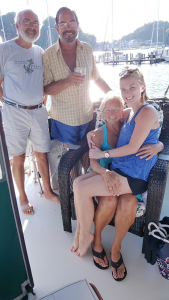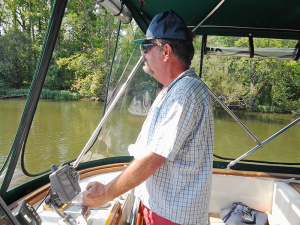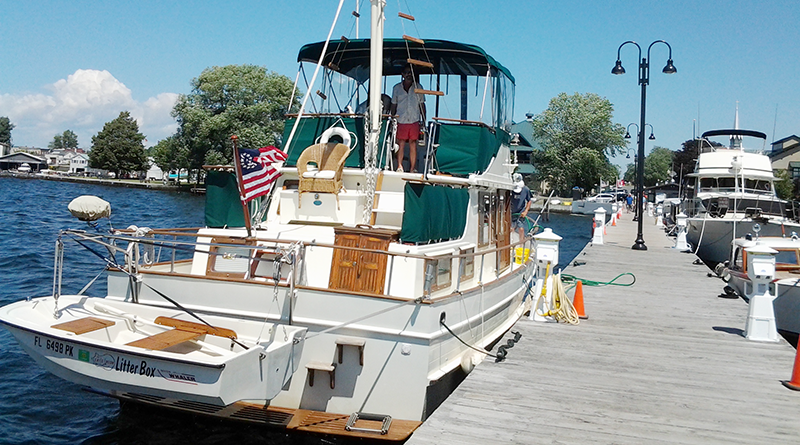Great Loopers
6,000-mile waterway trip challenges even the most grizzled of travelers
By Arn Albertini

It was a quiet, calm night on the Gulf of Mexico and Jay Rodman and Rob Hall were 20 hours into a 24-hour trip to cross the gulf.
Suddenly, the weather turned.
The wind started blowing in one direction, the current started flowing in another direction and the waves came at them from a third direction.
“We couldn’t go forward,” said Rodman, 69, remembering the trip recently. “The wind, waves and tide had us in irons.”
They kept the boat at full throttle, but the boat wasn’t moving forward, it was standing still, he said.
They steered the boat so it was facing into waves and let the wind and waves move them, a technique called crabbing, to shallower water where they could anchor, Rodman said.
“Everything [inside cabin] had broken,” he sad. “The beer bottles in the fridge exploded, the pantry came open and food was all over. Lamps broke in the living room.
“It was just like being in a salt shaker.”
This harrowing trip across the Gulf of Mexico was just one part of a 7,000-mile trip along a series of waterways on the eastern portion of North America.
The trip is known as the Great Loop and includes the Atlantic and Gulf intra costal waterways, the Great Lakes, the Canadian Heritage Canals and the inland rivers of America’s heartland. Rodman and Hall did the trip twice. The first time, they were on their own and the second time Rodman’s wife, Mary Jo, joined them.
The harrowing trip across the gulf was part of their first trip in 2011.
“In the Gulf of Mexico, there’s no place to run because the water is extra shallow,” said Rodman. “There’s no safe harbor for miles and miles. There was no choice but to ride it out in high waves.
What choice do you have? You have no choice. It’s where your experience, boating skills and the strength of your craft all come together. It’s man against the sea.”
Hall, 73, added, “You just have to learn to deal with it and that’s what we did. We’re still alive to tell about it so it wasn’t that bad.”
Throughout the Great Loop, it was always important to plan a route and try to work around the weather, but it was also important to be ready for the unexpected, he said.
Rodman added, “There’s a saying — the weather forecast is only as good as when you’re out in it.”
The later in the year it gets, the harder it is to find a good day to cross the gulf, he said.
“People can wait weeks to find a good day to cross the gulf once you get into the early winter months,” he said.
The advantage of traveling across the gulf is time. It’s a 24-hour trip as opposed to the three or four days it takes to go along the Florida panhandle, said Rodman.
On the second trip, they took a longer route.
“Generally speaking, it’s more enjoyable,” he said. “You get to visit places most boaters don’t get to see.”
Like Steinhatchee, Fla.
“It’s a beautiful marina. It’s a beautiful town. But 12 miles upriver at seven miles per hour — it’s a long way to go just for a place to spend the night. There are not many places you can get into to get off the gulf,” Rodman said.
On average, the Great Loop takes about a year, but that varies greatly, said Kim Russo, director of America’s Great Loop Cruisers’ Association. Some people do the trip in a few months and some take up to 12 years, she said.
It’s a highly seasonal trip, and you want to be on the northern parts in the summer and the southern parts in the winter, Russo said.
Since the association started in 1999, 1,400 boats have made the trip, she said. On average, less than 100 boats a year complete the trip, but 2016 was a record year with 127 boats completing the trip.
Typically, people travel on a trawler, like the Cat’s Meow the Rodmans and Hall took, but sometimes people travel by Jet Ski or dinghy. There are four people paddling the route using both kayaks and paddleboards. About 9 percent make the trip by sailboat, but “that can be cumbersome as you need to remove the mast to clear some of the bridges,” Russo said.
Trip of a lifetime
“It was marvelous every day,” said Hall. “It was just enjoyable to get up every morning and do the trip.
“We never had a bad moment even when we got into rough sea. Maybe I just have a different attitude on life.”
For Rodman, the Great Loop was a way to see a different side of the country.
“When you’re driving on the roads and on the main highways you see all the storefronts, the movie theaters, the restaurants; you see what’s in the town.”
But, when you’re on the canals and rivers of the Great Loop, you see a different side of town, he said. “You get to see the back side of America. It’s a whole different perspective.
“Some of the waterways date back to George Washington.”
Back then, there weren’t any good roads so the rivers and canals were the main way to get around. And that’s where industries started and in many cases towns grew out from the rivers’ banks, Rodman said.
Rodman is an avid boater. In addition to sailing boats, he also enjoys restoring antique boats. He grew up in Lakeville and his family has had a cottage on the water on Pebble Beach Road since the 1930s. The original cabin is gone, but a newer, two story home stands in its place with floor-to-ceiling windows facing the banks of the lake and a parlor filed with models of boats, maps and other nautical paraphernalia.
Hall is an old friend of the Rodmans. He married a high school friend of Mary Jo Rodman’s. Hall’s wife is deceased, but Hall and the Rodmans have bought several boats together and traveled together several times. The Rodmans split their time between Lakeville and Pine Island, Fla.
Hall, formerly of Lakeville, lives in Pine Island year-round.
Rodman is a freelance metal broker, which means he can work from his home in Lakeville on Lake Conesus or Pine Island, Fla. or even the boat, as long as there’s cell service and internet. Both Hall and Mary Jo Rodman are retired.
On the Cat’s Meow, the ship they sailed for the Great Loop, is a 1977 36-foot Marine Trader trawler single-engine Leeland. The boat came with the name and boaters consider it unlucky to change a boat’s name without going through several customary rituals, so they kept the name.
It has a washer/dryer, hot and cold running water, water maker and a full bath and shower.
“We all got along extremely well,” said Hall. “You have to be able to do that. You can’t have arguments among crew.
“I guess it was my idea,” he said of how they decided to take the Great Loop trip. “As Mary Jo would say, it was on my bucket list. I’d read about it and I’d always wanted to live on a boat.”
Rodman added, “This just felt like it would be a fun challenge. And it was.”
Each type of waterway requires a different type of navigation, he said.
In 2009, Hall and Rodman left from Pine Island, Fla. and headed east across Florida to the intra costal waterway all the way up to Norfolk, Va., where the waterway ends. Next, they motored through a series of lakes and rivers and canals to make it the rest of the way up the coast.
The waterways along the coast of New Jersey were some of the most challenging to navigate, said Rodman.
“A lot of boats wait until the ocean is calm and go out to sea rather than fight their way through the inner water ways of New Jersey,” he noted. “We went up the ditch from Cape May.”
The inner waterways in New Jersey are referred to as the ditch, he said.
This is partly because the waterway is poorly maintained, but also, there are several openings to the open ocean along the route, Rodman said. “Outside (on the ocean side) it’s just barrier islands. When the weather comes up, it can push sand in through the inlet, changing the course and depth of the water (in the waterway).”
So, navigating the water means navigating an ever-changing waterway; you’re never quite sure where the shallow parts might have moved to, he said.
But, if you decide to try the ocean, you’re in trouble if the weather turns bad as it’s 60 to 70 miles between harbors, Rodman said. “You’re stuck. There’s no place to drop anchor and it’s too far to get to a harbor. You have to ride it out,” he said.
But, once you get through the New Jersey waterway and pass through the New York Harbor, you get to the Hudson River. “It’s very quiet, almost challenge-free,” said Rodman. “It’s like a honeymoon.”
Hall and Rodman spent about three and a half months making the trip from Florida, up the coast, to New York Harbor, up the Hudson River to the Erie Canal and to Midlakes Marina in Macedon.
Two years later, in 2011, Hall and Rodman finished up the second half, traveling north across Lake Ontario, through the Trent Severn Canal into Georgian Bay, across Lake Huron, on to Lake Michigan and down to Chicago.
The Trent Severn Canal, which connects Lake Ontario with Lake Huron’s 47-lock canal, has a lock that lifts boats 65 feet into the air — high enough to get to the next section of the canal. At another spot, boats get put on slings in a cart that runs on tracks over a hill to get to the next section of canal.
From Chicago, they went down the Illinois River to the Mississippi River and then on to the Ohio and Cumberland rivers, through Lake Barkly and then into the Tennessee Tombigbee Waterway, which took them down to Mobile, Ala. where they emptied into the Gulf of Mexico.

Dodging debris
Mary Jo. Rodman joined Hall and Rodman’s for the second Great Loop, which they started from Florida in April 2015 and finished last fall.
They basically retraced the same route as the first trip, which meant they knew where the good marinas and anchorages were, how to maneuver through locks on the canals and how to get through other tricky parts of the trip, said Jay Rodman.
“You have more experience, which is invaluable. The second trip was much more relaxing and much more enjoyable. It was so much easier,” Rodman said.
And having another person on board is a big help as well, he said.
But, that doesn’t mean the trip was entirely smooth sailing.
When they got to the Mississippi this time, the river was at flood stage and it was moving fast.
“It was terrifying,” said Rodman. “There were whole trees floating down the channel.”
Sometimes they would see swirling water, like a whirlpool, in the middle of the channel. It was debris that got stuck and pulled under water by a buoy. You had to be careful because the debris could become untangled from the buoy and launch up, potentially shattering the hull of your boat, said Mary Jo. Rodman.
In addition to the added debris, there was also commercial barge traffic to work around.
“They can’t move very much so you have to,” she said.
When you approach a barge, sometimes there are as many as 25 barges tied together and pulled by tugboats. You radio the captain to see what side he or she wants you to pass the boat,” she said.
On the Mississippi, you travel a 200-mile stretch with no marinas and only a few good spots to anchor.
“You need an anchorage where you are safe from the water and from other boats,” she said.
At the head of the Mississippi, there’s one marina and just a series of barges tied together where boaters meet daily to hear about what conditions to expect and about good anchorages.
“Some days you may need to travel 12 to 14 hours to find a safe anchorage, and then, some days you can only go 15 or 20 miles because otherwise it’s too far to the next anchorage,” said Mary Jo. Rodman.
She said one of her favorite spots was the eastern coast of Lake Michigan.
“It’s a beautiful place to visit” “I don’t know why more people know about it.”
She also enjoyed Mackinac Island, and island off the coast of Michigan on Lake Huron with no cars. To get around, you need to travel by foot, bicycle or horseback. “It’s beautiful,” she said.
On this second trip, they spent an unplanned three weeks in Atlantic City, N.J.
They spent a few days waiting out some bad weather to the north, said Rodman. After that weather cleared up, they decided to stay a little longer to avoid arriving in New York City along with the throngs who would be celebrating the Fourth of July.
With the Independence Day celebrations complete, they were ready to set sail again, but heavy rains closed the Erie Canal, which was where they would need to end up after going through the harbor and up the Hudson River.
“These are the kinds of things that happen when you’re traveling,” Jay Rodman said.
And then there are the unexpected mechanical issues.
Rodman and Hall know the basics of boat mechanics so that they could keep the boat running smoothly and fix smaller things that went wrong, like a leaky hose or a broken water pump. “It makes a huge difference when you are able to do your own repairs,” said Rodman.
Hall added, “We never missed a day checking the oil and the transmission fluid. It’s the first thing we did every morning.”
But, early in the first trip, something went wrong with the transmission.
It was a $200 part, but cost just under $4,000 to fix, said Rodman, adding that marine mechanics is a highly specialized field, which makes repairs expensive.
And you can’t just pop a 27–foot long, 30-foot tall boat on a trailer and take it home to your local mechanic, said Rodman. “You can’t get the boat home without sawing the upper half off.”
There were several places on the trip where they had to take down their mast to clear bridges.
If you go
For those interested in braving the Great Loop, Redman recommends a good GPS as well as an extensive array of paper charts.
“A GPS gives you a screen-sized idea to where you are,” said Rodman. “To see where you are going, you need to navigate to another screen. With paper charts, you have much broader view on one or two pages of where you’re going to be traveling for that day or for that week. It’s much easier to plan and see what is going on for that day.”
Also, paper charts don’t crash like a GPS can.
“Your electric chart can go blue screen, but the paper chart never goes blue screen,” said Rodman.
Besides getting charts and a good GPS, Rodman suggests reading up on the waterways you’ll be navigating and contacting people who’ve done the trip before, such as through the American Great Loop Association. Rodman recommends getting “Skipper Bob,” a series of booklets that provide information about marinas and anchorages along the waterways of the Great Loop.
“Anyone trying to do this on their own would probably just give up,” Rodman said.

